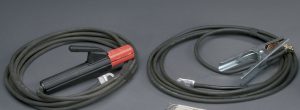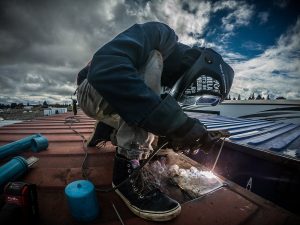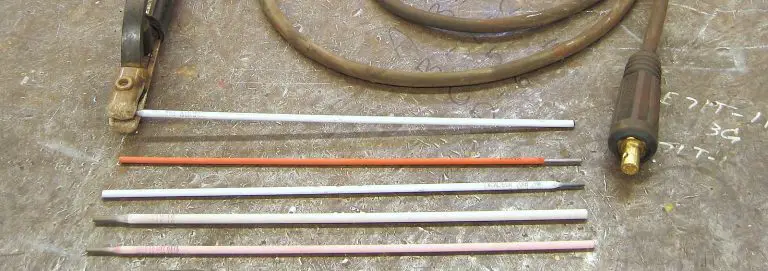Lead Sizes For Stick Welding- Sizes For Any Job
This post contains affiliate links.
Lead Sizes For Stick Welding

For a complete overview of Stick Welding, Click Here

Stick Welding “Leads” are the cables used to conduct current for the ground and the stinger components. They are industrial cables containing copper strands encased by a high quality, flexible rubber. The flexibility of the rubber can vary, and more flexible rubber tends to be more expensive.
The lead sizes for stick welding dictate the recommended amperage depending what rods you plan on burning. Obviously, the thicker leads are a lot heavier than the thinner leads due to the additional copper wire strands encased in rubber. Hobbyists and garage welders can tend to get away with smaller lead sizes because they aren’t exceeding their duty cycles on their machine, and they generally aren’t burning huge electrodes.
Whips
Pipeliners and ironworkers tend to use heavier gauge leads because they are burning thicker rods, running higher duty cycles, and abusing their leads more. Running a thicker lead can become tiresome because the welder is holding more weight when they are holding the stinger. This wouldn’t seem like an issue, but when stick welding is a full time job it can really get tiresome. Sometimes welders use what is called a “whip”. This is a thinner section of lead running off of their larger lead to their stinger. This makes holding the stinger less tiring because the suspended lead (from your stinger to the floor) is thinner in diameter.
I use a whip on my mobile welding rig because I have to hold my stinger for long hours. I can get away with using a smaller diameter whip because most of the 7018 and 6010 rods I am burning are only 3/32” in diameter. This is uncommon as most structural welders are and pipe welders are burning stick electrodes with a minimum 1/8″ diameter, and often 5/32″.
Connectors
“Tweco” style connectors are a popular way to cleanly attach whips, and are also good for attaching leads to your welding machine. There are many variations, but it is just a male/female way of connecting your leads. I tend to splice my whip directly to my stinger lead by splicing the copper wires together and then using electrical tape. It isn’t as pretty, but it gets the job done and isn’t as bulky. There’s a great video on this by pipeliner Austin Ross found here.
Dangers
A danger of using inadequate lead sizes is that you can burn up the internal copper strands of your leads. Since these copper strands are housed in rubber, you won’t know they’re fried until its too late. If you look at the inside of a lead that has been running too high of amperage for too long, the copper actually turns black and is less conductive of your needed amperage. With that being said, I would always suggest upsizing your leads to avoid this problem. Longer stints of arc time without a break can also contribute to degrading the integrity of your leads.
Having too small of lead sizes for stick welding can also overheat and damage your stinger. This can make it uncomfortable to hold as well as you will feel the heat through your welding gloves.
What To Start With
You may end up needing to use larger diameter electrodes down the line in your welding endeavors, so buying thicker leads to start with can save you time and money down the road. If you ever need to weld steel that is 1″ thick, you don’t want to ruin your equipment by using tiny leads.
If you plan on doing field work, I would recommend having about 100 feet of stinger lead and 100 feet of ground lead. This will allow you to work efficiently even if you can’t get your machine very close to the work area. Some welders prefer to have slightly less ground lead than stinger lead. This is because a lot of the time you can ground off your machine on a closer side of the workpiece (ie. a fence) and then pull your stinger further as you weld different areas. This isn’t always the case, so having identical lengths of ground and stinger lead is also beneficial.
If you are a hobbyist or welding around your house, you can get away with a 50 foot set of leads or even a 25 or 15 foot set.
Purchasing Leads
Many welding manufacturers will sell leads pre-made with the ground and stinger already connected, as well as the ring terminals on the back end. These tend to be overpriced. I prefer to buy my leads by the foot and piece together my own set. You can even choose different lead colors and pick out a stinger and a ground that you like. Some stick welding machines will come with a set of leads, so you may not need to shop right away. Different supply websites will vary in cost of the price per foot of lead, and certain rubbers will add to the cost.

Longer leads will need to be thicker to conduct the amperage. Please note that amperage drop can be a problem if you plan on using long leads. The longer the lead, the less amperage you’re actually getting to your stinger, despite what your machine is set at.
Amperage Chart
Below is a chart regarding lead sizes and recommended amperage. You will notice the lead sizes are numbered and the aught sizes are larger than all of the normal sizes (#1/0 is bigger than a #1)
| AMPS | 100 feet | 150 feet | 200 feet | 250 feet | 300 feet |
| 100 | # 4 | # 4 | # 2 | # 2 | # 1 |
| 150 | # 4 | # 2 | # 1 | # 1/0 | # 2/0 |
| 200 | # 2 | # 1 | # 1/0 | # 2/0 | # 3/0 |
| 250 | # 1 | # 1/0 | # 2/0 | # 3/0 | # 4/0 |
| 300 | # 1/0 | # 2/0 | # 3/0 | # 4/0 | |
| 350 | # 1/0 | # 3/0 | # 4/0 | ||
| 400 | # 2/0 | # 3/0 | |||
| 450 | # 2/0 | # 4/0 | |||
| 500 | # 3/0 | # 4/0 |
As you can see, a #2 cable can handle just about anything a hobbyist wanted to do. Going over 200 amps for stick welding is more rare, unless you’re doing large industrial jobs.

Leads By The Foot
Leads sold by the foot vary in price from about 60 cents all the way to 3 dollars a foot. This is due to the larger amount of copper in thicker lead sizes, as well as the quality of the rubber coating. There are a few lines of super flexible leads such as “UltraFlex”. These leads are usually orange in color and have a very ductile rubber coating on them. Full time welders tend to like these because they are more maneuverable in tight areas such as a pipeline, and tend to get caught on things less.
Wrap Up
In conclusion, I wouldn’t overthink the subject of leads when you are just getting into stick welding. The most important things are that a) your leads are long enough to reach your workpiece and b) your leads are heavy enough so that they can properly conduct your needed amperage current. You can always splice in an extra length of lead if needed, and it doesn’t take long to do.
Remember, you can always buy more lead to extend your setup, if need be.






